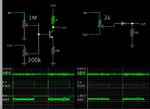SJ_ELECTRO
Newbie level 4
Dear friends,
I'd like some expert advise on how to pass the signal through a PMOS or NMOS device. I have a signal to be blocked and let through only when I need it. The signal to be controlled is a 5Vpkp sine and I want it to be stopped at particular periods during operation. I have tried some smart advise from youtube guys, but there seems to be a problem, the signal is being passed no matter what the gate voltage is. I used PMOS in my atempt.
regards
I'd like some expert advise on how to pass the signal through a PMOS or NMOS device. I have a signal to be blocked and let through only when I need it. The signal to be controlled is a 5Vpkp sine and I want it to be stopped at particular periods during operation. I have tried some smart advise from youtube guys, but there seems to be a problem, the signal is being passed no matter what the gate voltage is. I used PMOS in my atempt.
regards

